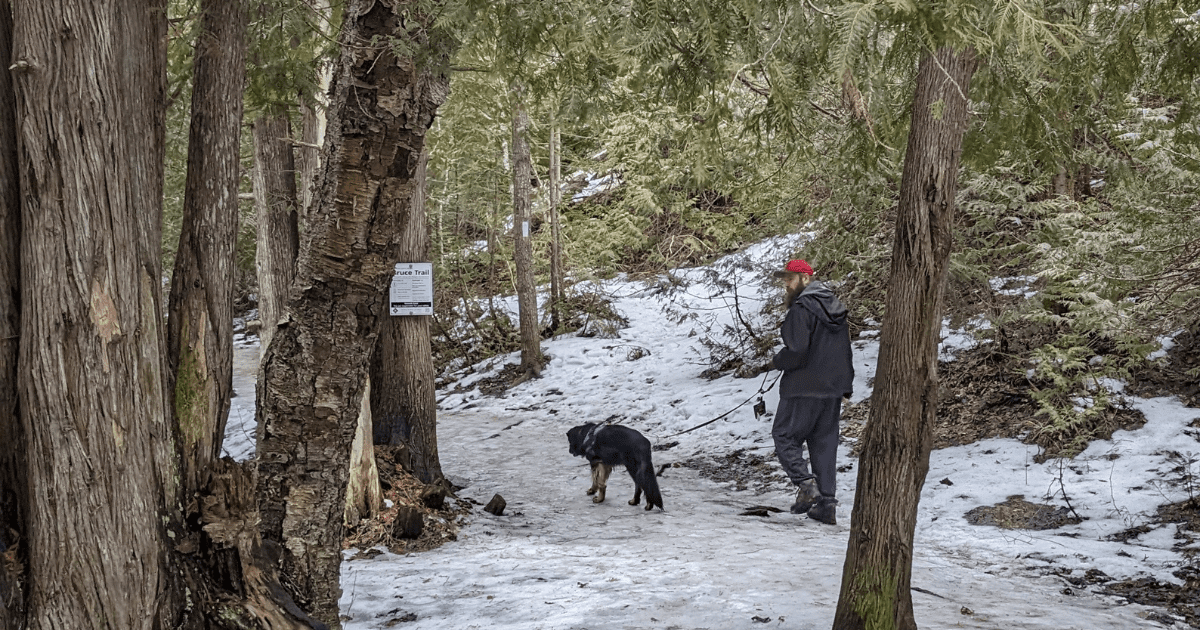Hiking the Bruce Trail with Dogs (and Cats)
Have you ever considered hiking the Bruce Trail, Ontario, with your best friend by your side? If so, you’re not alone!
This popular trail attracts more than 400,000 visitors each year.
However, if you’re part of our community, you’re likely considering hiking the Bruce Trail with dogs (or cats) by your side – which introduces some additional concerns and considerations.
We know first-hand, having researched and planned our own adventures on this epic trail.
In this blog post, we’ll dig into the critical information you need to enjoy the beauty of the Bruce Trail with your pup by your side.

This post contains affiliate links, which means if you click and buy, we will make a commission (at no cost to you). See my full disclosure policy for more details.
How Long is the Bruce Trail?
The well-known Bruce Trail stretches from the Niagara Escarpment to Tobermory, Ontario.
It is renowned in the hiking world as Canada’s oldest and longest continuous marked hiking trail.
The main trail itself is 840 km long.
However, it also features over 440 km of side trails for those who want to extend their adventure.
Due to the length of the trail and the challenges presented in finding camping along the way, most hikers complete this trail in segments.
However, some outdoor adventure lovers will take on the challenge of hiking it from start to finish.
Dogs on the Bruce Trail
Are dogs permitted on the Bruce Trail? For the most part, yes, but with some important rules and restrictions to remember.
Here are the most important rules to adhere to when hiking with dogs:
All Dogs Must Be On-Leash
There are no off-leash areas on the Bruce Trail, even if your dog is well-trained and has a rock-solid recall.
There are several reasons that this rule has been put in place.
First, there are the environmental considerations. Off-leash dogs are more likely to trample vegetation and native plants (wandering off the trail) or chase and injure wildlife.
There are also concerns about other hikers, such as those who are afraid of dogs. There may also be dogs on the trail who are nervous or reactive.
Letting your dog run up and greet people in either of these situations can lead to trouble.
While your pup specifically may be trained not to greet everyone they meet, this isn’t a standard that can be enforced adequately with all dogs using the trail.
Some areas of the Bruce Trail involve risks to your dog’s safety, like steep drops, ledges, poisonous plants, and local predators.
Keeping your dog on a leash and by your side allows you to keep your dog safe.
Finally, there are the restrictions and bylaws in different portions of the trail.
The Bruce Trail extends across a large portion of the province, navigating through many different towns and counties. It also crosses privately owned land.
In these areas, hikers must abide by local rules/laws and the wishes of private landowners.
Clean Up All Waste
Why is dog waste an issue? After all, it’s natural – Right?
Dog waste (and cat waste) can majorly impact the environment as they are not a natural part of the ecosystem.
Local wildlife feeds solely on the plants (or animals) in the area. This means their waste contains minerals and other substances already in the ecosystem.
Our pets, however, have an unrelated diet. Dog waste is high in nitrogen, which upsets this delicate balance in the water and soil.
This directly impacts the health of fish and plant life, with a ripple effect moving up the food chain.
Always pick up and bag pet waste, taking it with you to dispose of properly.
Respect Dog-Free Sections
Many parts of the trail (including many side trails) cross over private property. This means the landowners have a say in whether they will permit dogs on that section of the trail.
Some portions of the trail have been designated dog-free. These areas are identified on the Bruce Trail website as well as with signage on the trail itself.
As pet parents, we need to respect these signs if we want to continue to have access to the rest of the trail.
After all, these landowners permit strangers access to their property. They can revoke their permission anytime if they feel they are being taken advantage of.
This may mean skipping side trails or finding a way around dog-free sections of the main trail.
Can Cats Hike the Bruce Trail?
There are no rules specifically addressing adventure cats on the trail.
However, it is safe to assume that our cats should adhere to the rules in place for dogs.
This means keeping your cat on a leash (or in their backpack), cleaning up behind them, and avoiding dog-free zones.

Camping on the Bruce Trail
If you intend to do a thru-hike of the trail, camping along the way, you will face some challenges.
Some designated camping spots exist along the trail, but not enough for the full journey.
Those who take on this challenge often utilize bed & breakfast locations, cabin rentals, and other accommodations in nearby towns.
But we have good news! This is set to change in the coming years.
The Bruce Trail Conservancy has announced that they are prioritizing creating a proper thru-hiking experience as part of their 2030 strategy.
This means creating campsites along the length of the trail.
At this stage, they are still in the planning process. This means there aren’t solid plans or answers for how this will all look.
But we are excited to see what is to come.
Planning Your Hike of the Bruce Trail
Now, let’s get into the actionable part of this discussion—how to plan your Bruce Trail hike with your best friend.
This includes deciding which segment(s) of the trail you plan to hike, approximately how long it will take, any accommodations you may need, and what to pack for your adventure.
Let’s get started…
Where to Find Bruce Trail Maps
When planning to take on any portion of the Bruce Trail, the first consideration is identifying which part you plan to complete.
This requires identifying the trail itself and the many trailheads that provide access.
If you are trying to complete the whole trail, you may need to divide it into realistic segments for your schedule and skill level.
After all, it is estimated that a complete thru-hike would take approximately 30 days.
Alternatively, if you are like us, you may simply be looking to get out and enjoy a day trip to a portion of the trail close to home.
You can access maps and other tools to plan your trip on the Bruce Trail App.
It is available for both Android and iOS for $2.99/month or $29.99/year, with all proceeds supporting the Bruce Trail Conservancy.
Alternatively, there are downloadable PDF maps available on the Bruce Trail website.
Accommodations Along the Bruce Trail
If you plan on hiking the Bruce Trail with dogs (or cats) for multiple days, you must also find pet-friendly accommodations.
As we previously mentioned, there are a few camping locations along the trail.
You can download a complete PDF camping list on the website to learn more about these overnight options.
Unfortunately, there are segments of the trail where camping is not possible.
To help plan your hike in those areas, the Bruce Trail website includes a list and interactive map with roofed accommodations available along the trail.
What to Pack for Your Pet-Friendly Bruce Trail Hike
As we often discuss here on the blog and in our greater community, several gear items are absolutely necessary when hiking with your dog.
However, a list is often helpful if you are new to hiking. So, let’s do just that…
Before heading out on your pet-friendly Bruce Trail adventure, we recommend ensuring you have the following items:
- A pet-friendly first aid kit (a standard human first aid kit doesn’t have everything you may need)
- Plenty of water, either in a pet-friendly water bottle or accompanied by a collapsible water dish
- Food and treats to provide the fuel your pet will need along the way (and fuel for yourself, too)
- Plenty of doggy poop bags
- A tick key or tick removal tool
- An emergency evacuation harness if your dog is too large to carry for long distances comfortably
- A towel to wipe your pet clean at the end of your hike (this can be left in your vehicle as long as it is easily accessible)
- An LED collar or clip-on collar light if there is any possibility that you will be outdoors when the sun goes down
We also recommend downloading the Cairn app as a safety precaution, especially if you plan to hike solo.
You may wish to use a dog backpack to allow your pup to carry some of their gear, lightening your pack. But don’t expect them to carry an excessive amount.
It is recommended that dogs shouldn’t carry more than 25% of their body weight.
However, that also requires working up to that limit over time. Start with far less and allow your dog to build strength and endurance over time.
If you have a planned hike later in the year, start by introducing the dog backpack today.

Final Thoughts: Hiking the Bruce Trail with Dogs (and Cats)
Before heading out on the trail, take time to plan out your hike and any resources you may need.
This includes ensuring that you have packed all necessary gear, located trail heads where you will start and complete your trip, and decided on accommodations if required.
While the trail is largely dog-friendly (and, by extension, adventure cat-friendly), we must adhere to the rules in place.
Always leash your dog, clean up behind them, and avoid designated dog-free zones.
Whether you plan on taking on the incredible challenge of hiking the complete Bruce Trail in one go or enjoying the beauty of its individual segments and side trials, this is one trail we can’t recommend enough!
